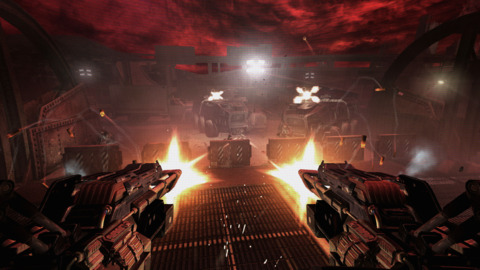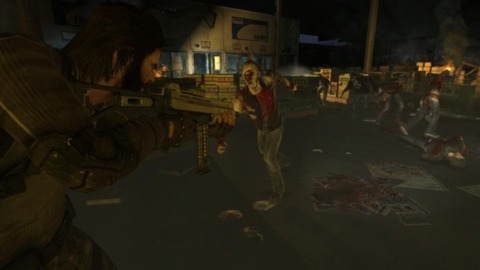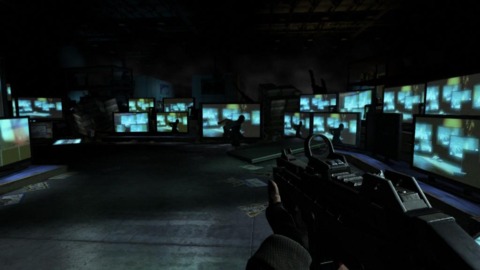
If F.E.A.R. were a movie franchise, F.E.A.R. 3 would be the direct-to-video sequel. Even though it picks up--and, ostensibly, ties together and concludes--the disturbing, apocalyptic threads left dangling by the first two F.E.A.R. games, the handoff from series developer Monolith Productions to Day 1 Studios is palpable. Rather than focusing on enhancing and exploring the stark atmosphere and high-tech tactics that has defined F.E.A.R. thus far, Day 1 seems more interested in incorporating elements from brand-name shooters like Call of Duty and Killzone, adding features without adding value. Even to this end, F.E.A.R. 3 doesn't crib with particular inspiration. It's an experience that feels diluted and common, a horror game afraid of its own shadow.
For what it's worth, Monolith left the series in a pretty crazy place at the end of F.E.A.R. 2, one that would require some serious commitment to top. After the all-out psychic warfare between the sinister Armacham Corporation, multiple paranormal/paramilitary F.E.A.R. teams, and that unkillable, stringy-haired J-horror arch-psychic Alma Wade, the seemingly quaint every-berg of Fairport is essentially a smoking hole in the ground populated by equally murderous psychos and mercenaries. Worse yet, Alma--having evolved from spooky ghost girl to spooky ghost teen--is pregnant, leaving all surviving parties scrambling to either harness her awful powers or put an end to her, once and for all.

Permanence, though, doesn't seem to mean much in F.E.A.R. 3. Paxton Fettel--the cannibalistic boogeyman from the first game--bounces right back from the point-blank trepanning provided by the Point Man, his brother and returning F.E.A.R. protagonist. Surprisingly cool about the whole attempted fratricide thing, and seemingly more powerful than ever in his ethereal new incarnation, Fettel frees the Point Man from Armacham clutches, and accompanies him as Pointy races towards some kind of resolution, acting as a bad conscience along the way.
More than Alma's tortured existence, her incredibly disturbing supernatural pregnancy, or even the increasingly imminent End of Days that have loomed large, the uneasy alliance between Paxton Fettel and the Point Man is the crux of F.E.A.R. 3. It's a direction that seems dictated by the decision to make cooperative play a big focus in F.E.A.R. 3, rather than a natural progression for the fiction.
Though the initial single-player experience puts you behind the Point Man's brooding beard, with all of the time-slowing abilities that accompany it, a second player can leap in at any time as Fettel, whose abilities contrast significantly. No bullet-time, and, in fact, Fettel can't even use conventional weapons by default, but he can possess enemies, simultaneously eliminating them as threats and turning whatever firepower they carry against their ill-fated compatriots. A new first-person cover system for both characters differentiates the overall feel from previous F.E.A.R. games.

With its shared, relatively short single-player and co-op structure, F.E.A.R. 3 seems to operate under the presumption that you'll want to play through these scenarios repeatedly--even if you have no interest in co-op, you can replay chapters as Fettel--but it's a flimsy premise at best, for a few reasons. Notably, the situations F.E.A.R. 3 puts you in just feel shopworn. There are a few sequences where you'll pilot powerful-if-trudging mechs, something that F.E.A.R. 2 did, and did better, but it's a lot of flavorless corridor crawling while peeking out from behind crates, punctuated by what are essentially wave-based survival encounters. Separate from the story, F.E.A.R. 3 has a handful of multiplayer modes that, at this point, shouldn't surprise you to learn feel an awful lot like the wave-based survival modes found in games like Call of Duty and Gears of War. Even the promisingly titled "Fucking Run" mode, where you have to chew through enemies while trying to outrun a constantly looming wall of death, is better in theory.
Uninspired combat scenarios and misguided cooperative elements aside, the biggest tragedy in F.E.A.R. 3 is that it's simply not scary, spooky, unnerving, or even a little bit surprising. Jump-scares and weird visions come predictably, though Alma is apparently too preoccupied to provide those very often. The game feels impatient, unwilling to allow any tension to build, constantly pushing you forward into the next firefight. I feel like it's incredibly telling that, in addition to a number of combat challenges that can earn you enhanced character abilities, each chapter has a pace time for you to beat. It's a point that tells players "don't worry about the mood, just run as fast as you can!" and it's a notion that's anathema to the spirit of F.E.A.R.. F.E.A.R. and F.E.A.R. 2 felt deliberately cinematic, but F.E.A.R. 3 goes in the exact opposite direction, and the naked gaminess robs it of any weight. That lack of weight extends to the game's look, which softens the shadowy, high-contrast feel and caricatures the characters, furthering a safer, cartoony feel, however gory it might be.
Whether you preferred the original F.E.A.R. or its sequel, F.E.A.R. 3 plays to the strengths of neither, almost feeling like a multiplayer spin-off that was begrudgingly upgraded to full-on sequel. There's a categorical compulsion here to play it safe, a mistake that even F.E.A.R. might not be able to return from.